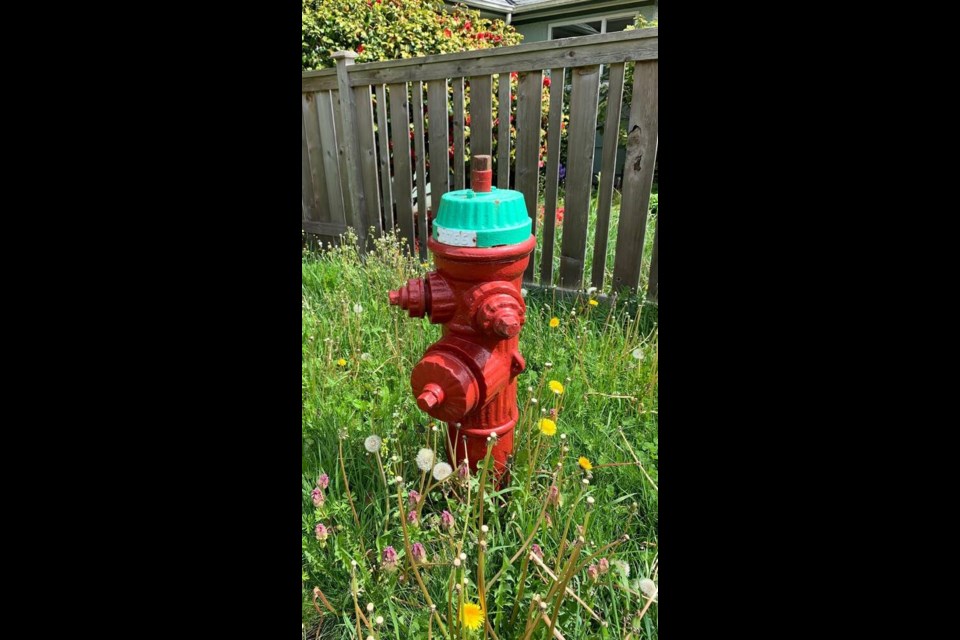Perhaps I was a dog in an earlier life. That might explain my keen interest in fire hydrants.
Now I know that bird watching has enjoyed a tremendous boost in popularity — especially over the last two years. With people on Vancouver Island doing so much neighbourhood walking, I’d like to make a pitch for a similar outdoor activity I call Hydrant Spotting.
A similar activity? Well, sort of. Both “birding” and hydrant spotting involve finding, identifying and recording what we see.
Hydrant spotting is a lot easier, and you don’t need binoculars. Birders have sighted over 500 bird species in British Columbia — more than anywhere else in Canada — but there are only about nine species of fire hydrants in Victoria itself, and a lot fewer beyond.
Unlike birds, hydrants tend to remain stationary — unless they’re knocked over by cars, trucks or heavy equipment. They aren’t startled by noises or sudden movement. You can take your time examining a fire hydrant. Just don’t be surprised by the strange looks from passersby or property owners if you do.
Unlike bird identification, it’s hard to distinguish hydrants by colour alone. In the city and Greater Victoria, hydrants of all kinds are painted red.
What does distinguish some hydrants is the colour of the tops or “bonnets,” which actually indicates the rate of water flow measured in gallons per minute. Showy blue bonnets do nothing to attract other hydrants, but they are very attractive to firefighters looking for high-water-volume hookups.
Unlike birds, hydrants make no distinctive calls, so sound is no help. Hydrant identification is all about what you see. Birders make tentative identifications based on size and shape. So do hydrant spotters.
When you look at a hydrant what do you see? Hydrants have two main sections. You see only the top three feet above the ground. There are another seven feet below.
Viewed from the streetside, a hydrant has two distinct parts: the body or “barrel,” and the bonnet.
The barrel has two or three capped outlets or ports. The two smaller ports on the sides connect directly to fire hoses.
Many hydrants have a larger outlet on the front, sometimes black-capped. It connects the hydrant to the pumper truck, which pumps water through the pumper’s attack hoses. A spotter will notice the number of ports and their position on the barrel.
If sound and colour aren’t helpful in identifying hydrant species, the markings on the barrel and bonnet sure are. They can offer very useful information — like the name of the manufacturer, the model number and sometimes the date.
Novice birders, afraid to call out an incorrect ID, would burn with envy. But hydrant identification can also be tricky.
The three most common hydrant brands in Victoria and the Island are Terminal City (TC) Iron Works, followed by Clow/McAvity and Canada Valve/Darling. Because of acquisitions, identical hydrants made by the same manufacturer sometimes bear different names or brand marks, so observe carefully.
Like the shape of a bird, the shape of the barrel or bonnet is an important guide to identification. Visiting the West Coast from Ontario, I was excited to see the hydrants made in B.C. When you look at TC 1 hydrants manufactured in Vancouver or at Victoria’s Ramsay’s Machine Works hydrants like the one I spotted near Topaz Park, their shapes are distinctly humanoid.
That’s how we come to identify hydrants — especially from a distance. We look at shape, features and configuration and create our own metaphors.
Does the barrel remind you of torpedoes or artillery shells? Probably a McAvity M67 or the newer Clow Brigadier M93.
Does it suggest a fountain of water expanding upward from a narrow base, or a frozen gusher? It’s a Canada Valve Century. Short, squat and round like a plug? Likely a Terminal City C71P.
Birders love lists. They make backyard lists, annual lists, country lists and special life lists, a running record of all the birds they’ve identified. Adding a new bird to a life list is called adding a tick.
Serious birders will travel long distances to see a rare species or a bird they’ve never seen. Are serious hydrant spotters different? Believe me, I didn’t come to Victoria to look for hydrants. But once I got here, I couldn’t resist.
When travelling, I’m drawn to hydrants I haven’t seen or that may soon disappear. Adding one of these to your list is adding what birders call a mega tick.
One great advantage of hydrant spotting in B.C. is that each hydrant has its own number. When I return to Victoria, I’ll head over to Lee Street to look for VMD (Victoria Machinery Depot) hydrant 0359, to Blanshard and Discovery to find Ludlow 0567, and to Broad and Fort streets to photograph Darling 0354. There are only a few left. Hopefully they’ll still be there.
Hydrant spotting is for everyone. It’s an all-age, all-season, individual or group pastime with no special equipment required. It can be competitive or co-operative, easy or difficult. It’s fun to play “guess the hydrant,” and active searching will definitely help you achieve your daily cardio fitness goal.
But there’s more. Hydrant spotting makes us more aware of both the natural and the complex “built” environment we inhabit. Hydrants are visible reminders of the services and systems above and below ground that allow us to live safely in our neighbourhoods and communities.
So the next time your dog pulls you towards a fire hydrant, go with the flow. You just might find yourself adding another tick to your growing Hydrants Spotted list.
Harvey Starkman lives in Toronto. Contact him at [email protected]



